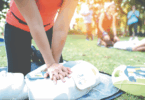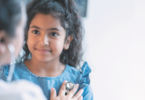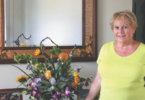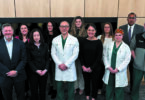You never know when you will be exactly the right person in the right place at the right time. UHS Gastroenterology Lab nurse Crystal Lewis, RN, recently was all three.
On March 13, Crystal and her husband Keith were on their way to drop off their 14-year-old daughter, Jillian, at soccer practice at the 434 Sportsplex in Vestal. Jillian’s best friend, Alex Aubel, 14, was also headed there with her mother, Melissa. The girls, both ninth graders at Owego Free Academy, were texting each other en route, planning to meet in the parking lot and walk inside together.
“I let Jillian out, and as I was parking, I heard yelling,” says Crystal. “I figured one of the kids had tripped in the parking lot and hit her head, so I got out of the car and went to help.” The situation she discovered was the last thing she would have imagined: “There was Alex, face-down on the ground, her backpack still on. She wasn’t breathing and was already grayish, and I could tell this was bad. I went into nurse mode, and just started going through all the steps in my head.”

Like all members of the UHS nursing team, Crystal Lewis, RN, received training in CPR and the use of AEDs. This training and her quick action saved Alex Aubel’s life.
While the team’s coach dialed 911 and other parents shepherded the rest of the team indoors, Crystal began CPR compressions and sent someone to get the building’s automated external defibrillator (AED). “It’s so strange—just a few weeks before, I had been talking with another mom and was wondering if the facility had an AED. She went and asked, so we knew it was there, and that the staff kept it maintained and ready for use,” says Crystal. When the AED was brought out, Crystal applied the patches and followed the machine’s instructions. “I’m trained to do this, but it was such a surreal situation—a 14-year-old I know well having an unexpected cardiac event—so the step-by-step the machine provided was a godsend.”
After applying one shock, Crystal continued compressions, and when the EMTs arrived less than five minutes after the coach’s 911 call, they checked Alex’s condition and found a pulse. “The best words I’ve ever heard in my entire life were, ‘We have a pulse,’” says Crystal. “The EMTs had to tell me more than once that I could stop so they could prepare Alex for transport.”
Taking Quick Action
After Alex was placed in the ambulance, she was taken to UHS Wilson Medical Center, and after just 10 minutes in the Emergency Department she was airlifted to Upstate Golisano Children’s Hospital in Syracuse, where she could be evaluated and treated by pediatric cardiology specialists. Her mom, Melissa, was by Alex’s side throughout the seemingly endless five minutes that elapsed before Alex’s heart began beating again; Melissa and her husband, Mike, drove to Syracuse to reunite with Alex at Golisano.
In Syracuse, Alex was diagnosed with long QT syndrome, a congenital condition that can cause fast, irregular heartbeats. Unless discovered incidentally on an EKG ordered for some other reason, the condition is a silent one until an arrhythmia strikes, usually when the individual is a young teen. Because CPR began literally moments after her collapse, Alex is alive with no cardiac or brain damage. The outcome for most patients is not typically such a happy one: Unless cardiac intervention begins immediately, as it did for Alex, most children in the same situation are not so lucky.
As part of her treatment, Alex will have an implantable cardioverter defibrillator, or ICD, for the rest of her life. The device acts as an internal AED. She now also takes a beta blocker to lower her blood pressure and reduce stress on her heart. Alex’s doctors are hopeful she will be able to resume her normal activities—including soccer—without limitations. Her cardiologist took the time to call Crystal: “He asked if I’d ever done CPR before, and I told him that other than training, I never had. He said what a good job I did and how well Alex was doing because of it.”
Community Connection
Sports and recreation are important to everyday life in the Southern Tier and help bring people together. Keeping our athletes healthy means creating a safe environment for them to learn and compete. Jay Hubbard, Sports Medicine field manager and lead athletic trainer at UHS Sports Medicine, explains why this is a priority:
“We strive to be the leaders in sports medicine services throughout this community,” he says. “As we have become more involved, the most important thing we bring to events is our first-aid kit and automated external defibrillator [AED]. To be able to offer that to the athlete population within the community is huge.”
Nowhere was this clearer than at the 434 Sportsplex in March, when UHS nurse Crystal Lewis, RN, saved a young woman’s life by performing CPR and using an AED (see main story to learn more). Mr. Hubbard and his team work with local schools and athletic departments throughout the region to ensure they have the resources needed to make sports safe. UHS’ portable AEDs also provide an important advantage: Because they are brought to the sidelines by a UHS team member, they are quickly accessible, compared to AEDs placed in buildings that may not be as easily accessible from the field.
For athletes and parents enjoying sports this fall, Mr. Hubbard encourages taking action if someone is in distress. “I always encourage people to act,” he says. “If you are certified in CPR, and someone is losing consciousness or not responsive, it is better to be safe and take action than be sorry.”
Prepared for Success
Crystal’s takeaway from her stressful but miraculous experience is the importance of learning CPR and AED skills, and being willing to apply them when necessary. “In the time since Alex’s collapse, I’ve said more than once that I will never complain about the recertification training we do,” she says. “It’s fantastic that UHS provides us with pediatric advanced life support, advanced life support and CPR training, and education in AED use. I feel like that knowledge gave me the calmness and courage to proceed and not second-guess myself. I’ve been with UHS for 15 years, and as I worked on Alex, I kept replaying my training in my head.”
While fortunately these types of events are rare, Alex’s situation is the exact type of emergency that UHS nurses are prepared for due to their CPR and AED training. “Being the cardiac care center for our community, it’s very important that our nurses are always prepared to provide the best and most comprehensive care,” says Kali Gehring, nurse and CPR program coordinator at UHS. “Our nurses are very involved in the community, whether it’s through sports, the schools or other organizations, and that helps provide another level of support for the community, knowing our staff are well-trained to help in an emergency.”
Ms. Gehring points out that, according to the American Heart Association, every minute that a person is in cardiac arrest and not receiving care reduces their likelihood of survival by 10 percent. “With Crystal being trained and able to jump in and provide care immediately, that made a big difference in what saved Alex’s life,” she explains.
When it comes to quick action, another factor is the availability of AED devices. “The No. 1 goal is to close the emergency situation within a three-minute timeframe,” says Jay Hubbard, Sports Medicine field manager and lead athletic trainer at UHS Sports Medicine. UHS has placed AEDs at important sites throughout the community, including the AED used to save Alex’s life at the 434 Sportsplex. Learn more about UHS’ promotion of safety in “Community Connection.”

Jillian Lewis and Alex Aubel, best friends and ninth-graders at Owego Free Academy, enjoy the sunshine after Alex’s medical emergency this past March.
A Tragedy Avoided
Long-time friends Melissa and Crystal are even closer thanks to this shared experience. “I’ve told Crystal I’m at her beck and call, forever,” Melissa laughed. Both women pointed to the sheer number of stars that aligned to make Alex’s deficit-free recovery possible: Jillian waited for Alex in the parking lot, so Crystal was still there and able to start CPR immediately. The coach called 911 right away. The facility had a charged AED on site. The other adults on hand did whatever was needed: Getting the AED, opening the case and activating the unit. “That girl has angels watching out for her—it was the best worst-case scenario you could have,” says Crystal.
National CPR and AED Awareness Week is observed every summer, so now’s the time to refresh existing skills or take your first-ever class. “CPR is something everyone should learn,” says Crystal. “You don’t have to be perfect at it, but being able to do something, anything, could mean the difference between life and death someday. Be prepared.”
SAVE A LIFE
For more information about CPR training at UHS, visit nyuhs.org.







